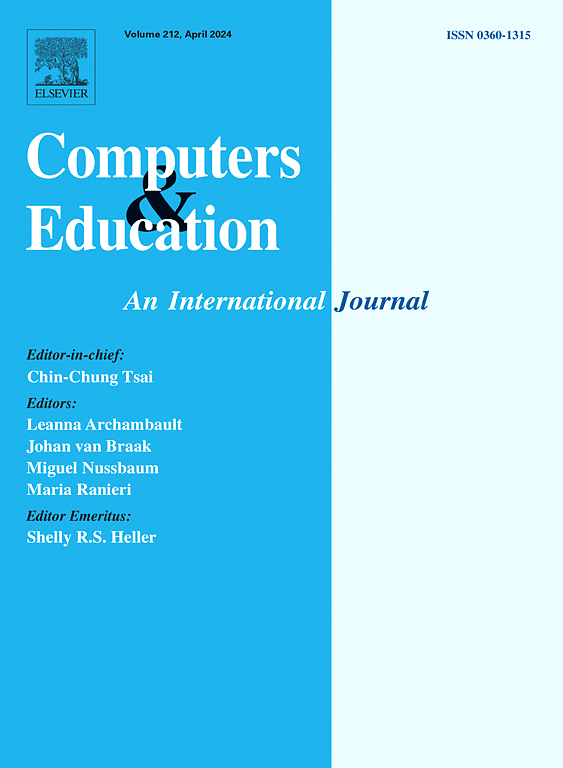通过生成式人工智能辅助数字故事创作提高职前教师的反思性思维能力:一个三维框架分析
IF 10.5
1区 教育学
Q1 COMPUTER SCIENCE, INTERDISCIPLINARY APPLICATIONS
引用次数: 0
摘要
在教师教育中,特别是在整合新兴技术的背景下,发展职前教师的反思性思维技能(RTS)仍然是一个挑战。虽然数字叙事(DST)在促进反思实践方面表现出了希望,但传统方法往往存在技术障碍,阻碍了更深入的反思。很少有研究探索生成人工智能(GAI)工具如何在DST创建期间支持RTS。本研究通过采用包括反思时间、反思对象和反思水平在内的RTS三维框架来解决这些空白,以指导和评估ai辅助下的DST创建对职前教师反思模式的影响。采用测试后准实验设计,80名职前教师被分为两组:实验组使用GAI工具(如ChatGPT、Midjourney、Runway)进行DST创作,对照组使用传统方法。结果显示,实验组在时间、对象和反射水平上显著提高了RTS。实验组职前教师在反思时间设计阶段对问题定义和解决方案产生的反思较多。在反射对象方面,实验组在自我、人工制品和环境方面表现出明显更高的反射频率。此外,实验组职前教师在单环、双环和三环的反射频率均显著高于对照组。在两组中,单回路反射最为常见,而三回路反射最少。这些发现强调了GAI支持RTS和增强DST创建过程的潜力,为将GAI整合到教师教育中以促进更深层次的反思实践提供了有价值的见解。本文章由计算机程序翻译,如有差异,请以英文原文为准。
Enhancing pre-service teachers' reflective thinking skills through generative AI-assisted digital storytelling creation: A three-dimensional framework analysis
Developing reflective thinking skills (RTS) in pre-service teachers remains a challenge in teacher education, particularly in the context of integrating emerging technologies. While digital storytelling (DST) has shown promise in fostering reflective practice, traditional methods often present technical barriers that hinder deeper reflection. Few studies have explored how generative artificial intelligence (GAI) tools can support RTS during DST creation. This study addresses these gaps by adopting a three-dimensional framework of RTS, which included the time of reflection, objects of reflection, and levels of reflection, to guide and assess the impact of GAI-assisted DST creation on pre-service teachers' reflective patterns. Employing a post-test quasi-experimental design, eighty pre-service teachers were divided into two groups: an experimental group utilizing GAI tools (e.g., ChatGPT, Midjourney, Runway) for DST creation, and a control group utilizing traditional methods. Results revealed that the experimental group significantly improved RTS in time, objects, and levels of reflection. Pre-service teachers in the experimental group reflected more on problem definition and solution generation during the design stages of reflection time. Regarding reflection objects, the experimental group exhibited significantly higher reflection frequencies across self, artifacts, and circumstances aspects. Additionally, pre-service teachers in experimental group demonstrated significantly higher reflection frequencies at all levels—single-loop, double-loop, and triple-loop—compared to the control group. Single-loop reflection was the most common, while triple-loop reflection was the least frequent in both groups. These findings underline GAI's potential to scaffold RTS and enhance the DST creation process, offering valuable insights for integrating GAI into teacher education to foster deeper reflective practice.
求助全文
通过发布文献求助,成功后即可免费获取论文全文。
去求助
来源期刊

Computers & Education
工程技术-计算机:跨学科应用
CiteScore
27.10
自引率
5.80%
发文量
204
审稿时长
42 days
期刊介绍:
Computers & Education seeks to advance understanding of how digital technology can improve education by publishing high-quality research that expands both theory and practice. The journal welcomes research papers exploring the pedagogical applications of digital technology, with a focus broad enough to appeal to the wider education community.
 求助内容:
求助内容: 应助结果提醒方式:
应助结果提醒方式:


